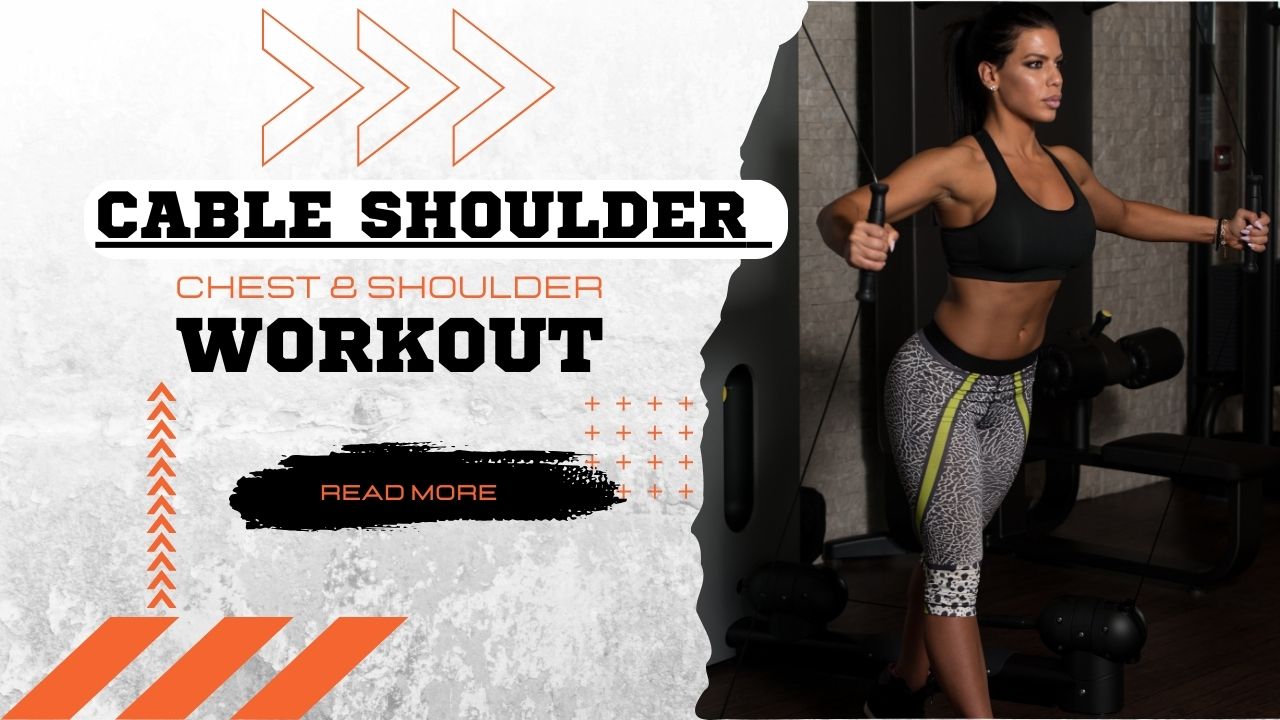6 Best Cable Shoulder Workouts

Summary
Are your shoulder workouts feeling stale and ineffective? 💪 It’s time to shake things up and supercharge your gains with cable machines! These versatile pieces of equipment offer a unique way to target your deltoids, providing constant tension throughout each movement for maximum muscle engagement.

Imagine sculpting perfectly rounded shoulders that command attention and boost your confidence. 🏋️♀️ With cable shoulder workouts, you can achieve just that. Whether you’re a gym newbie or a seasoned lifter, these exercises offer benefits that traditional free weights simply can’t match.
In this blog post, we’ll dive into six shoulder-shredding cable workouts that will revolutionize your upper body routine. From the classic cable shoulder press to the lesser-known cable face pulls, we’ll cover a range of exercises designed to hit every angle of your delts. Get ready to discover how these powerful movements can take your shoulder development to the next level!
Table of Contents
Benefits of Cable Shoulder Workouts

A. Constant tension for muscle growth
Cable machines provide a unique advantage over free weights: constant tension throughout the entire range of motion. This continuous resistance ensures that your shoulder muscles are engaged from the start to the finish of each repetition, maximizing muscle activation and growth potential.
B. Versatility in exercise selection
Cable machines offer unparalleled versatility for shoulder workouts. With adjustable pulleys and various attachments, you can target your shoulders from multiple angles, allowing for a comprehensive workout that addresses all three deltoid heads (front, side, and rear).
| Deltoid Head | Cable Exercise Examples |
|---|---|
| Front | Cable Front Raises, Cable Shoulder Press |
| Side | Cable Lateral Raises, Upright Rows |
| Rear | Cable Face Pulls, Reverse Flyes |
C. Joint-friendly movements
Cable exercises often provide a smoother, more controlled motion compared to free weights. This reduced impact on joints makes cable workouts particularly beneficial for those with shoulder issues or seeking to prevent injuries.
D. Improved muscle definition
The consistent resistance and varied angles offered by cable machines contribute to enhanced muscle definition. By targeting the shoulders from multiple directions, you can sculpt well-rounded, defined deltoids.
- Allows for isolation of specific muscle groups
- Enables drop sets and supersets for increased intensity
- Facilitates unilateral training for balanced development
Now that we’ve explored the benefits of cable shoulder workouts, let’s dive into specific exercises, starting with the Cable Shoulder Press.
6 Best Cable Shoulder Workouts To Build Mass & Strength are listed bellow :
1. Cable Shoulder Press

Proper Form and Technique
To perform the Cable Shoulder Press effectively:
- Stand facing away from the cable machine
- Grasp handles at shoulder height
- Keep core tight and maintain a neutral spine
- Press handles overhead until arms are fully extended
- Lower handles back to starting position with control
Muscle Engagement
The Cable Shoulder Press primarily targets:
- Front deltoids
- Lateral deltoids
- Triceps
- Upper chest (secondary)
| Muscle Group | Engagement Level |
|---|---|
| Front Deltoids | Primary |
| Lateral Deltoids | Primary |
| Triceps | Secondary |
| Upper Chest | Secondary |
Variations and Progressions
Try these variations to challenge yourself:
- Single-arm cable shoulder press
- Seated cable shoulder press
- Alternating cable shoulder press
- Kneeling cable shoulder press
Tips for Maximizing Results
- Focus on maintaining tension throughout the movement
- Experiment with different grip positions
- Incorporate pauses at the top of the movement
- Adjust cable height for varied muscle activation
The Cable Shoulder Press offers consistent resistance throughout the range of motion, enhancing muscle activation and promoting balanced shoulder development. This exercise is particularly effective for building strength and hypertrophy in the deltoids while minimizing the risk of injury compared to free-weight alternatives. As we move forward, we’ll explore another powerful cable exercise for shoulder development: the Cable Upright Row.
2. Cable Upright Row

Proper Form and Technique
The cable upright row is an excellent exercise for targeting multiple shoulder muscles, particularly the lateral and anterior deltoids. To perform this exercise correctly:
- Stand facing the cable machine with feet shoulder-width apart
- Grasp the cable attachment with an overhand grip, hands close together
- Pull the cable straight up towards your chin, keeping elbows higher than forearms
- Pause briefly at the top, then slowly lower back to starting position
Muscle Engagement and Benefits
The cable upright row offers several advantages:
- Targets multiple shoulder muscles
- Provides constant tension throughout the movement
- Allows for smoother, more controlled motion compared to free weights
| Muscle Group | Level of Engagement |
|---|---|
| Lateral Deltoids | Primary |
| Anterior Deltoids | Secondary |
| Trapezius | Secondary |
| Biceps | Stabilizer |
Variations and Progressions
To keep your workouts challenging and effective, consider these variations:
- Single-arm cable upright row
- Wide-grip cable upright row
- Seated cable upright row
- Alternating cable upright row
As you progress, gradually increase the weight or adjust your grip width to target different areas of the shoulders. Remember to maintain proper form throughout the exercise to maximize muscle activation and minimize the risk of injury. Now that we’ve covered the cable upright row, let’s move on to another effective shoulder exercise: the single cable front raise.
3. Single Cable Front Raise

Proper Form and Technique
The single cable front raise is an excellent exercise for targeting the front deltoids. To perform this exercise:
- Stand facing away from the cable machine
- Grasp the cable handle with one hand
- Keep a slight bend in your elbow
- Raise your arm in front of you until it’s parallel to the ground
- Slowly lower back to the starting position
Muscle Engagement and Benefits
This exercise primarily targets the anterior deltoid, but also engages:
- Front deltoid (primary)
- Upper chest
- Serratus anterior
| Muscle Group | Level of Engagement |
|---|---|
| Front Deltoid | High |
| Upper Chest | Moderate |
| Serratus Anterior | Low |
Variations and Modifications
To maximize muscle activation and prevent plateaus, try these variations:
- Alternating arms
- Seated cable front raise
- Incline bench cable front raise
Integration into Your Workout Routine
Incorporate the single cable front raise into your shoulder routine for enhanced muscle definition and strength building. It pairs well with other cable exercises like lateral raises and face pulls for a comprehensive shoulder workout.
Now that we’ve covered the single cable front raise, let’s move on to another effective shoulder exercise: cable lateral raises.
4. Cable Lateral Raises

Proper Form and Technique
Cable lateral raises are an excellent exercise for targeting the side deltoids, providing consistent resistance throughout the movement. To perform this exercise correctly:
- Stand sideways to the cable machine
- Grasp the handle with your outside hand
- Keep a slight bend in your elbow
- Raise your arm to shoulder height
- Lower the weight slowly and controlled
Variations and Modifications
| Variation | Description | Target Area |
|---|---|---|
| Single-arm | Performed one arm at a time | Emphasizes side deltoid |
| Double-arm | Using both arms simultaneously | Balanced shoulder development |
| Seated | Performed while seated | Reduces body swing |
| Leaning | Lean away from the machine | Increases range of motion |
Benefits for Shoulder Development
Cable lateral raises offer several advantages for shoulder development:
- Enhanced muscle activation due to constant tension
- Improved muscle definition and hypertrophy
- Versatility in adjusting resistance and angles
- Reduced risk of injury compared to free weights
By incorporating cable lateral raises into your workout routine, you can effectively target your side deltoids, contributing to overall shoulder strength and aesthetics. This exercise complements other shoulder movements, ensuring balanced muscle development and supporting your fitness goals.
5. Cable Face Pulls

Cable Face Pulls
Cable face pulls are an excellent exercise for targeting the posterior deltoids and upper back muscles. This movement not only helps build shoulder strength but also promotes better posture and reduces the risk of shoulder injuries.
Proper Form and Technique
To perform cable face pulls correctly:
- Set the cable machine to chest height
- Attach a rope attachment to the cable
- Grasp the rope with an overhand grip
- Step back and lean slightly forward
- Pull the rope towards your face, keeping elbows high
- Squeeze shoulder blades together at the end of the movement
- Slowly return to the starting position
Muscle Engagement and Benefits
| Muscle Group | Level of Activation |
|---|---|
| Rear Deltoids | High |
| Upper Trapezius | Moderate |
| Rhomboids | Moderate |
| Rotator Cuff | Low to Moderate |
Cable face pulls offer several benefits:
- Improved shoulder stability
- Enhanced posture
- Balanced shoulder development
- Reduced risk of shoulder impingement
Variations and Progressions
To keep your workouts challenging and effective, try these variations:
- Single-arm face pulls
- Face pulls with external rotation
- Kneeling face pulls
- High-to-low face pulls
As you progress, increase the weight or adjust your body position to make the exercise more challenging. Remember to maintain proper form throughout the movement to maximize muscle activation and minimize injury risk.
6. Shoulder Cable Kneeling Press

Shoulder Cable Kneeling Press
The Shoulder Cable Kneeling Press is an excellent exercise for targeting the deltoids, particularly the front and middle heads. This variation of the traditional shoulder press offers unique benefits due to its kneeling position and the use of cable resistance.
Muscle Engagement and Benefits
| Muscle Group | Level of Activation |
|---|---|
| Front Deltoid | High |
| Middle Deltoid | Moderate to High |
| Triceps | Moderate |
| Core | Moderate |
- Enhanced muscle activation due to constant tension from cables
- Improved stability and core engagement from kneeling position
- Reduced lower back stress compared to standing presses
- Versatility in resistance adjustment for progressive overload
Proper Form and Technique
- Kneel in front of a cable machine with one knee up
- Grasp the cable handles at shoulder height
- Press the handles upward and slightly forward
- Slowly lower the handles back to starting position
- Maintain a neutral spine throughout the movement
Integration into Your Workout Routine
The Shoulder Cable Kneeling Press can be an excellent addition to your shoulder development program. It’s particularly effective for hypertrophy and muscle definition when performed with moderate weights and higher repetitions. For strength building, increase the resistance and lower the rep range.
Now that we’ve covered this unique shoulder exercise, let’s recap the benefits of incorporating cable workouts into your shoulder routine.

Cable shoulder workouts offer a versatile and effective way to build strength and definition in your deltoids. By incorporating exercises like the cable shoulder press, upright row, front raise, lateral raises, face pulls, and kneeling press, you can target all three heads of your shoulder muscles for comprehensive development.
These cable-based exercises provide constant tension throughout the range of motion, allowing for better muscle engagement and growth. Whether you’re a beginner or an experienced lifter, adding these six shoulder cable workouts to your routine can help you achieve your fitness goals and sculpt impressive shoulders. Remember to focus on proper form and gradually increase the resistance as you progress to maximize your results.





